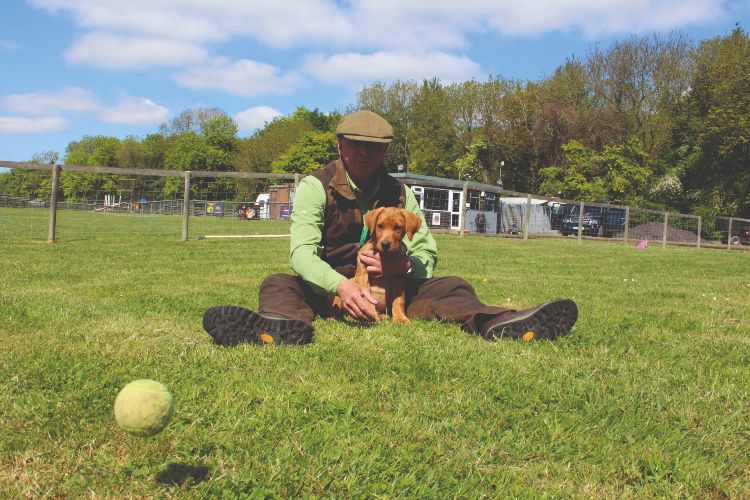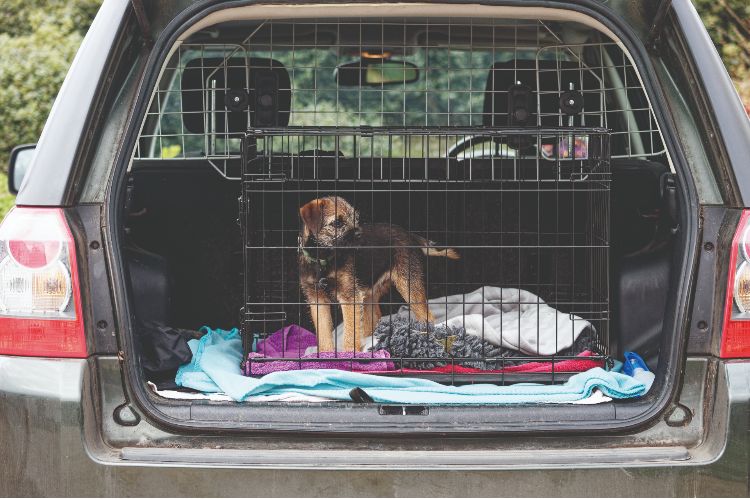Correct use of a crate in a puppy’s early life doesn’t just help with house training – it benefits the entire gundog training journey, says Howard. Here’s how to get it right.
There are of course many different views as to how you should approach the training of your gundog. How old a young puppy should be, and the techniques that you might use, are two subjects that usually promote a lot of discussion and differences of opinion. For those reasons I intend to use this month’s article to take a look at the approach we currently choose here at Mullenscote.
You’ll notice that I deliberately say ’the approach we currently choose’. As a group of trainers we constantly study, debate and explore the constantly evolving techniques and ideas that appear in the dog training world. This is an approach that I would encourage anyone involved with dog training to take. Be open minded and prepared to really listen to advice. Whether you choose to apply the use of new techniques is something that needs careful consideration. Assuming you might have chosen to take advice from a trainer, I think it would be wise to discuss the pros and cons of training and techniques with them. There are many implications to the approach we take when training dogs and a healthy discussion with your trainer can be both fascinating and helpful. Taking a new approach or ideas could be a really positive ‘game changer’. Equally, introducing an alternative technique may have negative implications.
It’s important to remember that the trainer that you’ve chosen to take advice from has produced multiple dogs that are well schooled. The training plans they use clearly work and prove to be consistently successful, therefore it is my view that you should apply considerable thought before changing something that clearly works.
However! I’m going to repeat myself here because it’s really important, do not be frightened to explore alternative thoughts and techniques, just run them by people with experience before jumping in with both feet, lead, whistle, clicker, treats, fancy dummies, dummy launcher, atmospheric scents, calming coats, headwear and a zillion other behaviour modifying bits of kit. There’s an awful lot of stuff and associated ideas out there. Ask questions of yourself, try, watch, study and learn from others too. Discuss your thoughts and ideas with your trainer (who might be an experienced friend) – they really won’t mind.
 What age should I start crate training my puppy?
What age should I start crate training my puppy?
There are various suggestions bandied around as to when you should start training your dog. “Oh, I don’t start any training until my dogs are six months old, they need to be a puppy first,” is a commonly misunderstood statement given by an experienced trainer. This is easily misinterpreted; what they usually mean is that the youngster won’t begin its formal training until it’s six months old. Even kennelled puppies will be learning to sit and wait for their food, recall and various other snippets of basic training.
For most people a gundog puppy will live indoors with a family. Toilet training, familiarisation with a crate, learning to settle and be by themselves are things that will require immediate attention.
Unfortunately, these essentials are often missed by very well-intentioned owners. We regularly see dogs that are six months plus with toilet training issues. Almost all have been encouraged to be with their owners almost constantly. The puppy has been allowed to ‘free range’ around the house which consequently means the puppy doesn’t settle, and is constantly interrupted by human activity; this leads to random toilet behaviour and a puppy that develops all manner of destructive and nuisance behaviour. These owners are then constantly fussing and chastising the overactive youngster. Almost all these cases will be nipping, jumping up, stealing, resource guarding and terrorising the children and house cats. In fact, the owners have accidentally ‘written the book’ on how not to train a young puppy. Un-doing this behavioural mess is now an unnecessary uphill struggle. Investing in and correctly training your puppy to use and settle in its crate is an essential.
 8 Top Tips for Crate Training
8 Top Tips for Crate Training
- Choose a crate that is the correct size for your puppy. One that the dog can comfortably stand up and turn around in. Be careful not to start with one that’s too big. Dogs don’t like to go to the toilet in their bed, but if the crate is too big they are more likely to wake up and empty themselves. Every time the puppy wakes you must take it outside to avoid accidents.
- Ensure the crate is set on a stable floor. A crate that wobbles or slides when the pup goes into it could be frightening. Wire cages rattle and a tentative pup could easily be put off.
- Place some bedding, a blanket, or vet bed inside. Most breeders will send you home with a piece of bedding that smells of the bitch and the pup’s litter mates.
- The crate must be a place that brings positive associations to the puppy. Food, praise, chews, rest, safety and security.
- Be patient, don’t rush, be consistent. Open the door to the crate and quietly place food treats near the door. Gradually put the food further into the crate until the pup is confidently going in, eating the food before turning around and coming back out. Wait until the puppy is starting to look to settle down and is tired (eight-week-old puppies fade quickly).
- Now introduce a chew or Kong stuffed with feed treats. If necessary, also throw the food you’ve been using to lure the pup into the cage. If the chew is of value to the puppy it will immediately become focused on it. Whilst the puppy is busy with the chew, quietly shut the door of the crate and sit beside it. Now you’ll need to use your common sense. If the puppy is happy and involved or, even better, settles itself in the crate then leave the door shut. Irrespective of what happens try to open the crate door before the puppy gets agitated and starts to protest at being shut in.
- We are trying to get the puppy as comfortable in the crate as possible for settling the puppy down for the night. It’s highly unlikely that an eight-week-old puppy will sleep through the night, some will. Belt and braces is to place the crate in your bedroom. If the puppy can see, smell and hear you it’s likely to settle quicker. The old-school method of leaving the pup to cry itself to sleep is fraught with potential problems but you should expect a degree of protest. Resist any interaction and most will settle.
- Importantly you’ll need to sleep ‘with one eye open.’ As soon as he wakes, leap out of bed and carry the little monkey outside to empty itself.
Further details on where to put a puppy crate
As I wrote tip number seven, I’m conscious that some of you will be whooping with excitement at the prospect of having baby Fido sleep at your bedside. Some will be wanting to take a baseball bat to my knees. Before you start to hunt me down, please read on!
Keeping the crate close to your bed (or option 2 is to sleep on the sofa) is only a temporary measure. Over the coming weeks, your puppy will gradually become more confident and his bladder will develop so he can hold himself for longer. This will allow you to leave the dog in the crate for progressively longer periods of time, also giving you the opportunity to encourage the puppy to settle downstairs in your chosen dog room.
Start right!
There are loads of very useful crate training tips on the internet that you should read. If you start to crate train your puppy from day one it will be really significant in helping you to manage your pup right through its development from puppy to adulthood. The continued use of a crate in vehicles and as a mobile but familiar doggy bedroom that you can fold down and take with you when visiting friends, family or staying in hotels is a godsend. As I mentioned at the beginning of this article, many of the problematic consultations that I do stem from households that don’t opt into the use of a crate. Many people still see the crate as a prison and struggle to see past this. Used properly it will be highly instrumental in the successful nurturing and training of any young puppy.
I’m writing this article whilst on a trip to the North Pennines. We are up here for two to three weeks’ grouse counting on some of the most exciting grouse moors in the world. This trip enables us to work our adult dogs whilst facilitating incredible opportunities to train our youngsters. I’m having the time of my life whilst training my dogs. I sincerely hope that wherever you are training, you are able to enjoy your dogs as much as I am right now!